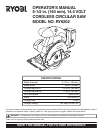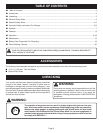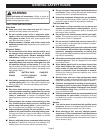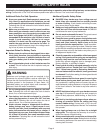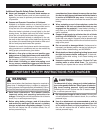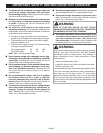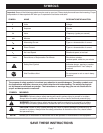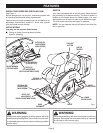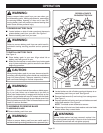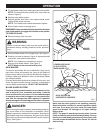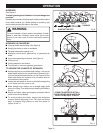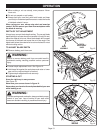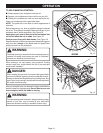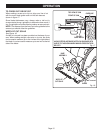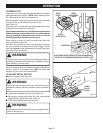
Page 4
Additional Rules For Safe Operation
■ Know your power tool. Read operator’s manual care-
fully. Learn its applications and limitations, as well
as the specific potential hazards related to this tool.
Following this rule will reduce the risk of electric shock,
fire, or serious injury.
■ Make sure your extension cord is in good condition.
When using an extension cord, be sure to use one
heavy enough to carry the current your product will
draw. A wire gage size (A.W.G.) of at least 16 is rec-
ommended for an extension cord 100 feet or less in
length. A cord exceeding 100 feet is not recom-
mended. If in doubt, use the next heavier gage. The
smaller the gage number, the heavier the cord. An
undersized cord will cause a drop in line voltage result-
ing in loss of power and overheating.
Important Rules For Battery Tools
■ Battery tools do not have to be plugged into an elec-
trical outlet; therefore, they are always in operating
condition. Be aware of possible hazards when not
using your battery tool or when changing accesso-
ries.
■ Do not place battery tools or their batteries near fire
or heat. This will reduce the risk of explosion and pos-
sible injury.
WARNING:
Batteries vent hydrogen gas and can explode in the
presence of a source of ignition, such as a pilot light. To
reduce the risk of serious personal injury, never use any
cordless product in the presence of open flame. An
exploded battery can propel debris and chemicals. If
exposed, flush with water immediately.
■ Do not charge battery tool in a damp or wet loca-
tion. Following this rule will reduce the risk of electric
shock, fire, or serious personal injury.
■ Your battery tool should be charged in a location
where the temperature is more than 50°F but less
than 100°F. Following this rule will reduce the risk of
electric shock, fire, or serious personal injury.
■ Under extreme usage or temperature conditions,
battery leakage may occur. If liquid comes in con-
tact with your skin, wash immediately with soap and
water, then neutralize with lemon juice or vinegar. If
liquid gets into your eyes, flush them with clean water
for at least 10 minutes, then seek immediate medi-
cal attention. Following this rule will reduce the risk of
serious personal injury.
Hold tool by insulated gripping surfaces when performing an operation where the cutting tool may contact hidden
wiring. Contact with a "live" wire will make exposed metal parts of the tool "live" and shock the operator.
Additional Specific Safety Rules
■ DANGER! Keep hands away from cutting area and
blade. Keep your second hand on auxiliary handle
or motor housing. If both hands are holding the saw,
they cannot be cut by the blade.
■ Keep your body positioned to either side of the saw
blade, but not in line with the saw blade. KICKBACK
could cause the saw to jump backwards.
■ Do not reach underneath the work. The guard cannot
protect you from the blade below the work.
■ Check the lower guard for proper closing before each
use. Do not operate saw if lower guard does not move
freely and close instantly. Never clamp or tie the
lower guard into the open position . If saw is acciden-
tally dropped, lower guard may be bent. Raise the lower
guard with the retracting handle and make sure it moves
freely and does not touch the blade or any other part, in
all angles and depths of cut.
■ Check the operation and condition of the lower guard
spring. If the guard and the spring are not operating
properly, they must be serviced before use. Lower
guard may operate sluggishly due to damaged parts,
gummy deposits, or a buildup of debris.
■ Lower guard should be retracted manually only for
special cuts such as “Pocket Cuts” and “Compound
Cuts”. Raise lower guard by Retracting Handle. As
soon as blade enters the material, lower guard must
be released. For all other sawing, the lower guard should
operate automatically.
■ Always observe that the lower guard is covering the
blade before placing saw down on bench or floor.
An unprotected, coasting blade will cause the saw to
walk backwards, cutting whatever is in its path. Be aware
of the time it takes for the blade to stop after switch is
released.
■ NEVER hold piece being cut in your hands or across
your leg. It is important to support the work properly to
minimize body exposure, blade binding, or loss of con-
trol.
■ Hold tool by insulating gripping surfaces when per-
forming an operation where the cutting tool may
contact hidden wiring. Contact with a “live” wire will
also make exposed metal parts of the tool “live” and shock
the operator.
■ When ripping always use a rip fence for a straight
edge guide. This improves the accuracy of cut and re-
duces the chance of blade binding.
■ Always use blades with correct size and shape (dia-
mond vs. round) arbor holes. Blades that do not match
the mounting hardware of the saw will run eccentrically,
causing loss of control.
SPECIFIC SAFETY RULES



